Economics Essay: Pluralism and Behavioral Economics
VerifiedAdded on 2020/05/08
|7
|1439
|48
Essay
AI Summary
This essay delves into the concept of pluralism in economics, specifically examining the contributions and criticisms of behavioral economics and neuroeconomics. It begins by introducing these fields and their challenges to conventional economic models. The essay then explores the criticisms of Gul and Pesendorfer, highlighting their concerns about the methodologies and applicability of neuroeconomics. A comparative analysis is presented, arguing that behavioral economics is more compelling, particularly in accounting and control, due to its insights into human decision-making processes, which often deviate from perfect rationality. The essay emphasizes the practical applications of behavioral economics in understanding and influencing choices, contrasting it with neuroeconomics' limitations in this regard. Overall, the analysis underscores the importance of considering both rational and non-rational aspects of behavior in economic models and decision-making, with a conclusion favoring behavioral economics for its methodological strengths and practical utility.
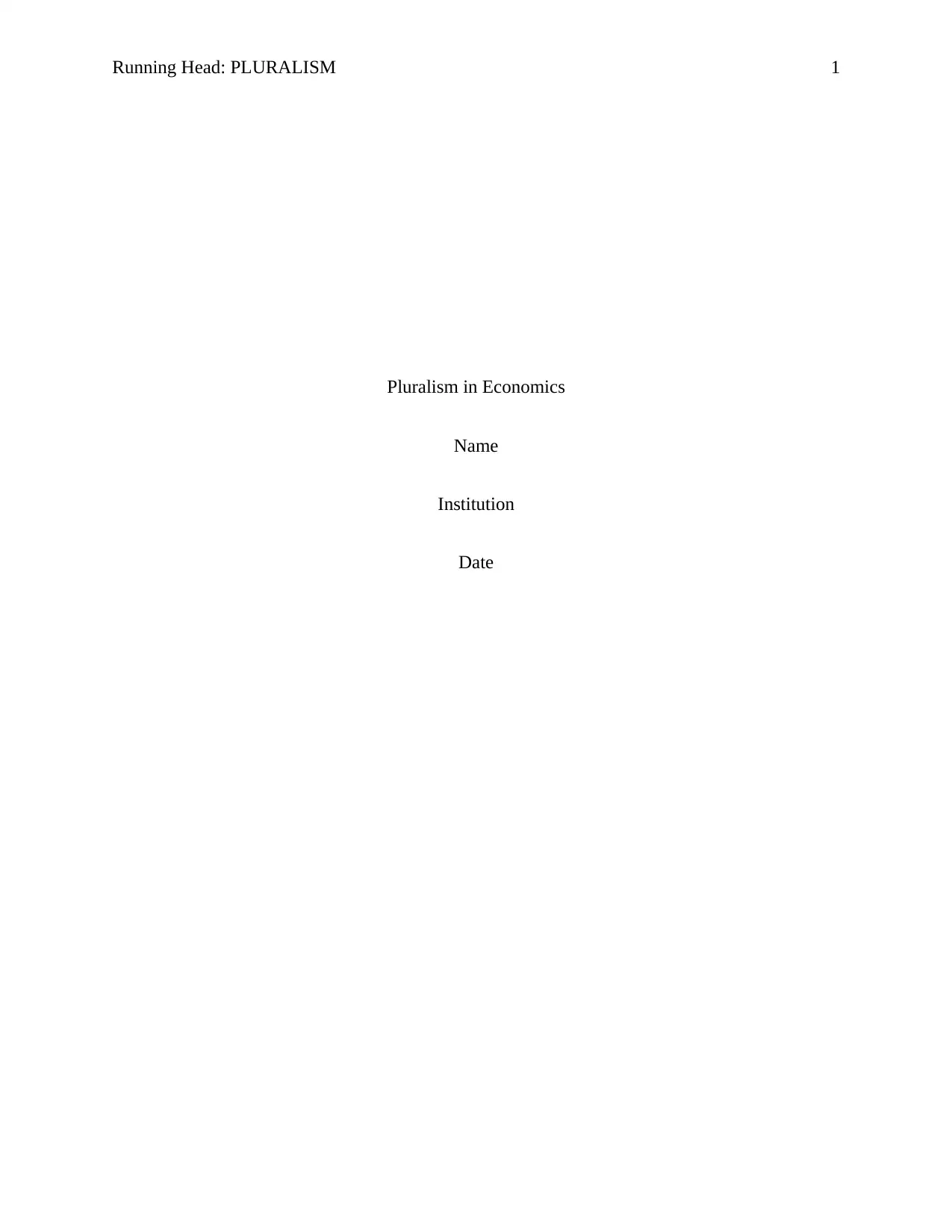
Running Head: PLURALISM 1
Pluralism in Economics
Name
Institution
Date
Pluralism in Economics
Name
Institution
Date
Secure Best Marks with AI Grader
Need help grading? Try our AI Grader for instant feedback on your assignments.
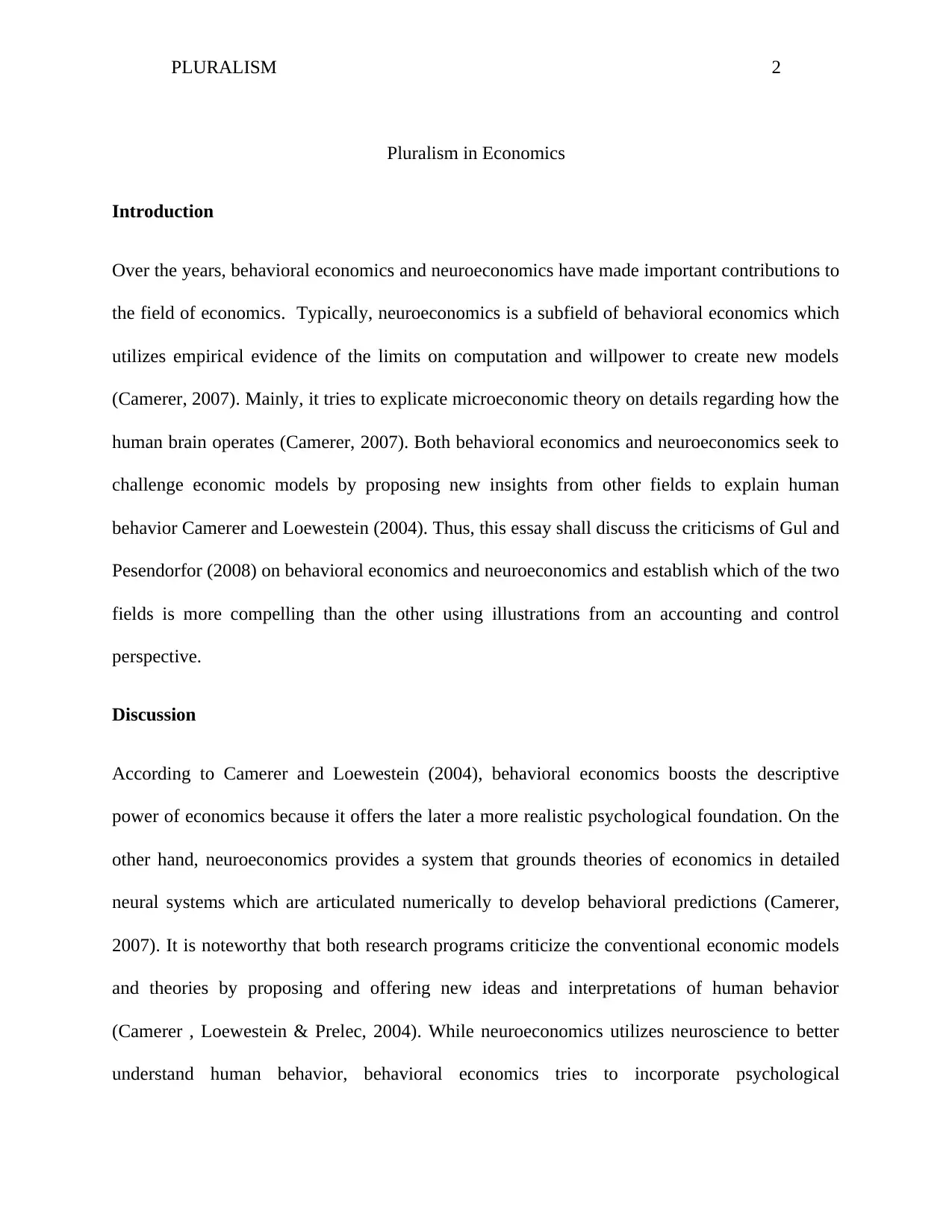
PLURALISM 2
Pluralism in Economics
Introduction
Over the years, behavioral economics and neuroeconomics have made important contributions to
the field of economics. Typically, neuroeconomics is a subfield of behavioral economics which
utilizes empirical evidence of the limits on computation and willpower to create new models
(Camerer, 2007). Mainly, it tries to explicate microeconomic theory on details regarding how the
human brain operates (Camerer, 2007). Both behavioral economics and neuroeconomics seek to
challenge economic models by proposing new insights from other fields to explain human
behavior Camerer and Loewestein (2004). Thus, this essay shall discuss the criticisms of Gul and
Pesendorfor (2008) on behavioral economics and neuroeconomics and establish which of the two
fields is more compelling than the other using illustrations from an accounting and control
perspective.
Discussion
According to Camerer and Loewestein (2004), behavioral economics boosts the descriptive
power of economics because it offers the later a more realistic psychological foundation. On the
other hand, neuroeconomics provides a system that grounds theories of economics in detailed
neural systems which are articulated numerically to develop behavioral predictions (Camerer,
2007). It is noteworthy that both research programs criticize the conventional economic models
and theories by proposing and offering new ideas and interpretations of human behavior
(Camerer , Loewestein & Prelec, 2004). While neuroeconomics utilizes neuroscience to better
understand human behavior, behavioral economics tries to incorporate psychological
Pluralism in Economics
Introduction
Over the years, behavioral economics and neuroeconomics have made important contributions to
the field of economics. Typically, neuroeconomics is a subfield of behavioral economics which
utilizes empirical evidence of the limits on computation and willpower to create new models
(Camerer, 2007). Mainly, it tries to explicate microeconomic theory on details regarding how the
human brain operates (Camerer, 2007). Both behavioral economics and neuroeconomics seek to
challenge economic models by proposing new insights from other fields to explain human
behavior Camerer and Loewestein (2004). Thus, this essay shall discuss the criticisms of Gul and
Pesendorfor (2008) on behavioral economics and neuroeconomics and establish which of the two
fields is more compelling than the other using illustrations from an accounting and control
perspective.
Discussion
According to Camerer and Loewestein (2004), behavioral economics boosts the descriptive
power of economics because it offers the later a more realistic psychological foundation. On the
other hand, neuroeconomics provides a system that grounds theories of economics in detailed
neural systems which are articulated numerically to develop behavioral predictions (Camerer,
2007). It is noteworthy that both research programs criticize the conventional economic models
and theories by proposing and offering new ideas and interpretations of human behavior
(Camerer , Loewestein & Prelec, 2004). While neuroeconomics utilizes neuroscience to better
understand human behavior, behavioral economics tries to incorporate psychological
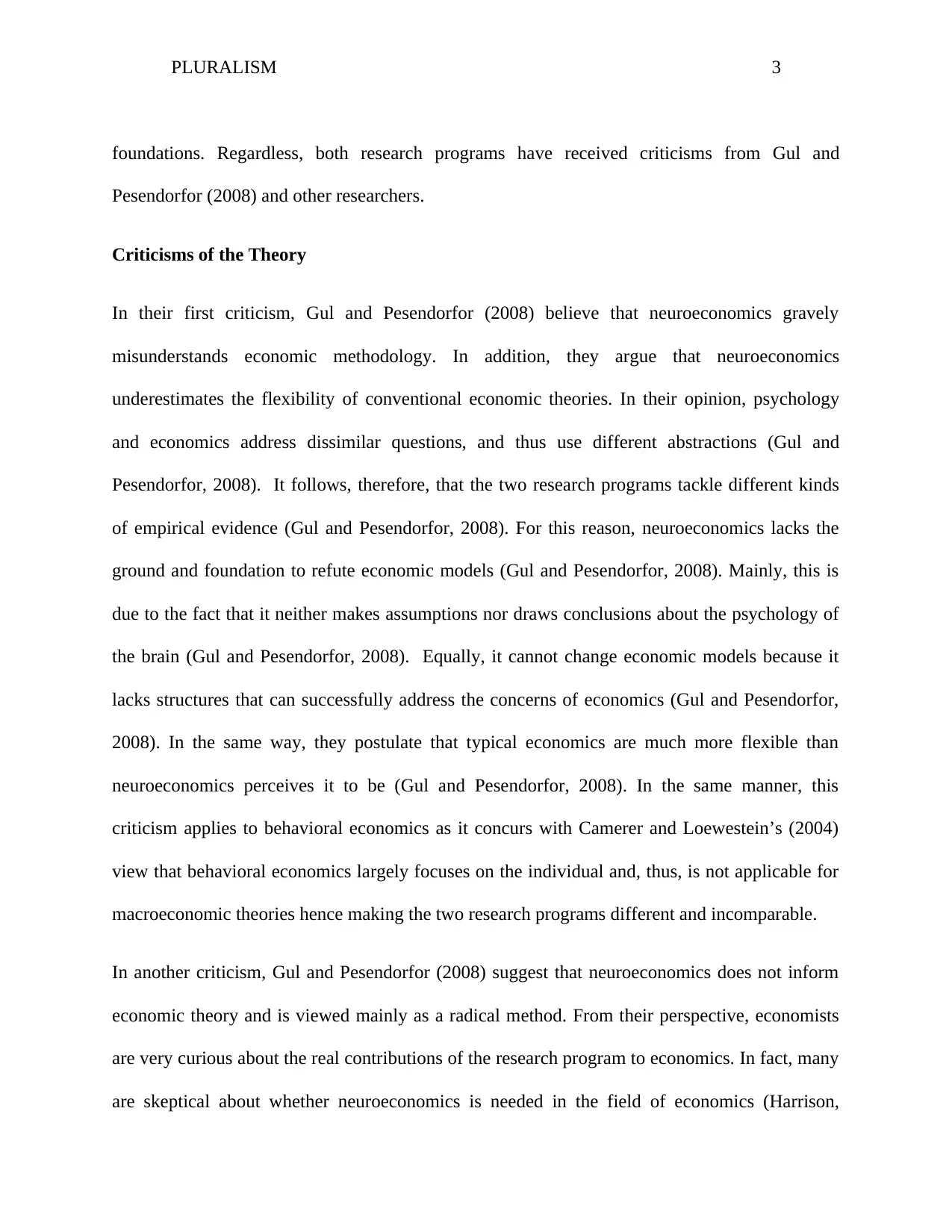
PLURALISM 3
foundations. Regardless, both research programs have received criticisms from Gul and
Pesendorfor (2008) and other researchers.
Criticisms of the Theory
In their first criticism, Gul and Pesendorfor (2008) believe that neuroeconomics gravely
misunderstands economic methodology. In addition, they argue that neuroeconomics
underestimates the flexibility of conventional economic theories. In their opinion, psychology
and economics address dissimilar questions, and thus use different abstractions (Gul and
Pesendorfor, 2008). It follows, therefore, that the two research programs tackle different kinds
of empirical evidence (Gul and Pesendorfor, 2008). For this reason, neuroeconomics lacks the
ground and foundation to refute economic models (Gul and Pesendorfor, 2008). Mainly, this is
due to the fact that it neither makes assumptions nor draws conclusions about the psychology of
the brain (Gul and Pesendorfor, 2008). Equally, it cannot change economic models because it
lacks structures that can successfully address the concerns of economics (Gul and Pesendorfor,
2008). In the same way, they postulate that typical economics are much more flexible than
neuroeconomics perceives it to be (Gul and Pesendorfor, 2008). In the same manner, this
criticism applies to behavioral economics as it concurs with Camerer and Loewestein’s (2004)
view that behavioral economics largely focuses on the individual and, thus, is not applicable for
macroeconomic theories hence making the two research programs different and incomparable.
In another criticism, Gul and Pesendorfor (2008) suggest that neuroeconomics does not inform
economic theory and is viewed mainly as a radical method. From their perspective, economists
are very curious about the real contributions of the research program to economics. In fact, many
are skeptical about whether neuroeconomics is needed in the field of economics (Harrison,
foundations. Regardless, both research programs have received criticisms from Gul and
Pesendorfor (2008) and other researchers.
Criticisms of the Theory
In their first criticism, Gul and Pesendorfor (2008) believe that neuroeconomics gravely
misunderstands economic methodology. In addition, they argue that neuroeconomics
underestimates the flexibility of conventional economic theories. In their opinion, psychology
and economics address dissimilar questions, and thus use different abstractions (Gul and
Pesendorfor, 2008). It follows, therefore, that the two research programs tackle different kinds
of empirical evidence (Gul and Pesendorfor, 2008). For this reason, neuroeconomics lacks the
ground and foundation to refute economic models (Gul and Pesendorfor, 2008). Mainly, this is
due to the fact that it neither makes assumptions nor draws conclusions about the psychology of
the brain (Gul and Pesendorfor, 2008). Equally, it cannot change economic models because it
lacks structures that can successfully address the concerns of economics (Gul and Pesendorfor,
2008). In the same way, they postulate that typical economics are much more flexible than
neuroeconomics perceives it to be (Gul and Pesendorfor, 2008). In the same manner, this
criticism applies to behavioral economics as it concurs with Camerer and Loewestein’s (2004)
view that behavioral economics largely focuses on the individual and, thus, is not applicable for
macroeconomic theories hence making the two research programs different and incomparable.
In another criticism, Gul and Pesendorfor (2008) suggest that neuroeconomics does not inform
economic theory and is viewed mainly as a radical method. From their perspective, economists
are very curious about the real contributions of the research program to economics. In fact, many
are skeptical about whether neuroeconomics is needed in the field of economics (Harrison,
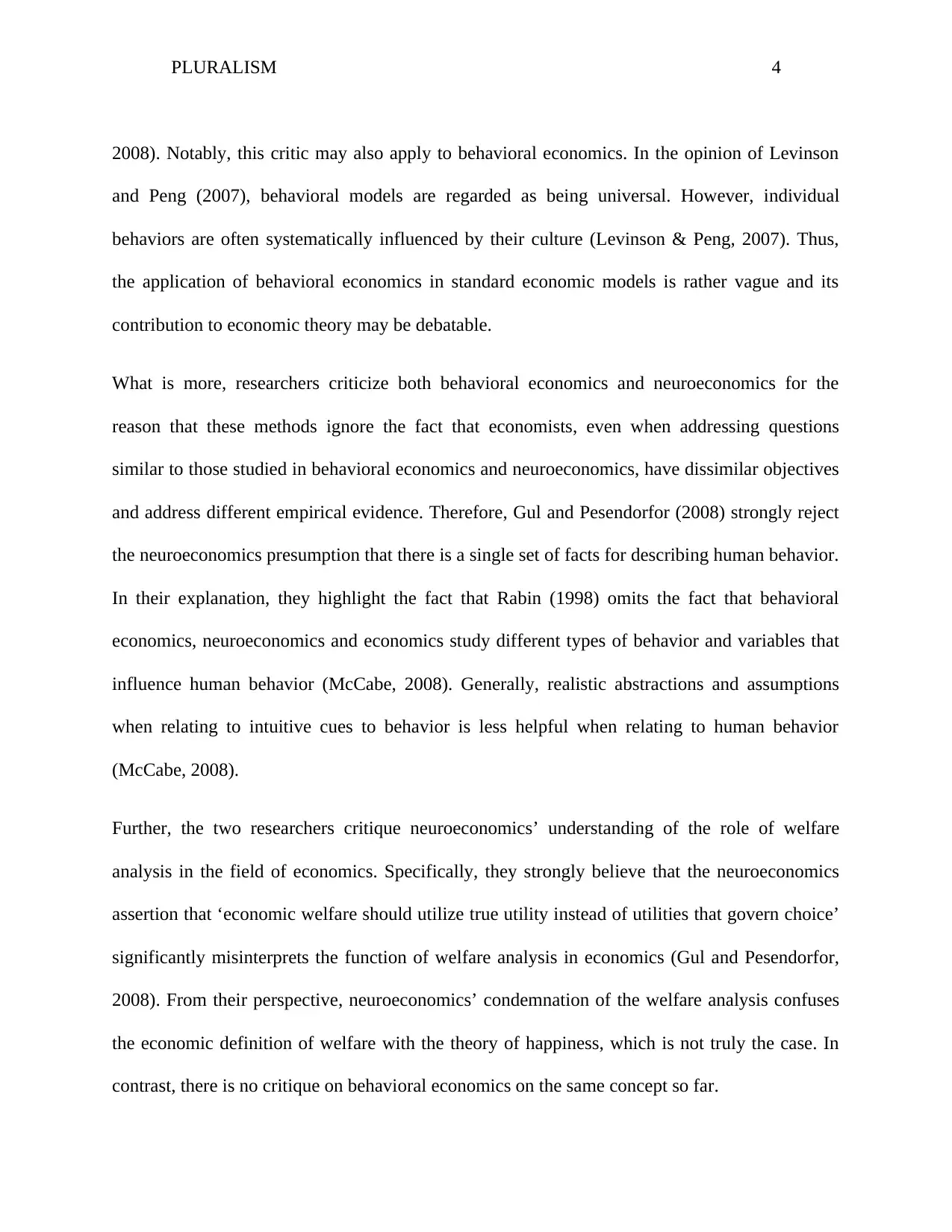
PLURALISM 4
2008). Notably, this critic may also apply to behavioral economics. In the opinion of Levinson
and Peng (2007), behavioral models are regarded as being universal. However, individual
behaviors are often systematically influenced by their culture (Levinson & Peng, 2007). Thus,
the application of behavioral economics in standard economic models is rather vague and its
contribution to economic theory may be debatable.
What is more, researchers criticize both behavioral economics and neuroeconomics for the
reason that these methods ignore the fact that economists, even when addressing questions
similar to those studied in behavioral economics and neuroeconomics, have dissimilar objectives
and address different empirical evidence. Therefore, Gul and Pesendorfor (2008) strongly reject
the neuroeconomics presumption that there is a single set of facts for describing human behavior.
In their explanation, they highlight the fact that Rabin (1998) omits the fact that behavioral
economics, neuroeconomics and economics study different types of behavior and variables that
influence human behavior (McCabe, 2008). Generally, realistic abstractions and assumptions
when relating to intuitive cues to behavior is less helpful when relating to human behavior
(McCabe, 2008).
Further, the two researchers critique neuroeconomics’ understanding of the role of welfare
analysis in the field of economics. Specifically, they strongly believe that the neuroeconomics
assertion that ‘economic welfare should utilize true utility instead of utilities that govern choice’
significantly misinterprets the function of welfare analysis in economics (Gul and Pesendorfor,
2008). From their perspective, neuroeconomics’ condemnation of the welfare analysis confuses
the economic definition of welfare with the theory of happiness, which is not truly the case. In
contrast, there is no critique on behavioral economics on the same concept so far.
2008). Notably, this critic may also apply to behavioral economics. In the opinion of Levinson
and Peng (2007), behavioral models are regarded as being universal. However, individual
behaviors are often systematically influenced by their culture (Levinson & Peng, 2007). Thus,
the application of behavioral economics in standard economic models is rather vague and its
contribution to economic theory may be debatable.
What is more, researchers criticize both behavioral economics and neuroeconomics for the
reason that these methods ignore the fact that economists, even when addressing questions
similar to those studied in behavioral economics and neuroeconomics, have dissimilar objectives
and address different empirical evidence. Therefore, Gul and Pesendorfor (2008) strongly reject
the neuroeconomics presumption that there is a single set of facts for describing human behavior.
In their explanation, they highlight the fact that Rabin (1998) omits the fact that behavioral
economics, neuroeconomics and economics study different types of behavior and variables that
influence human behavior (McCabe, 2008). Generally, realistic abstractions and assumptions
when relating to intuitive cues to behavior is less helpful when relating to human behavior
(McCabe, 2008).
Further, the two researchers critique neuroeconomics’ understanding of the role of welfare
analysis in the field of economics. Specifically, they strongly believe that the neuroeconomics
assertion that ‘economic welfare should utilize true utility instead of utilities that govern choice’
significantly misinterprets the function of welfare analysis in economics (Gul and Pesendorfor,
2008). From their perspective, neuroeconomics’ condemnation of the welfare analysis confuses
the economic definition of welfare with the theory of happiness, which is not truly the case. In
contrast, there is no critique on behavioral economics on the same concept so far.
Secure Best Marks with AI Grader
Need help grading? Try our AI Grader for instant feedback on your assignments.
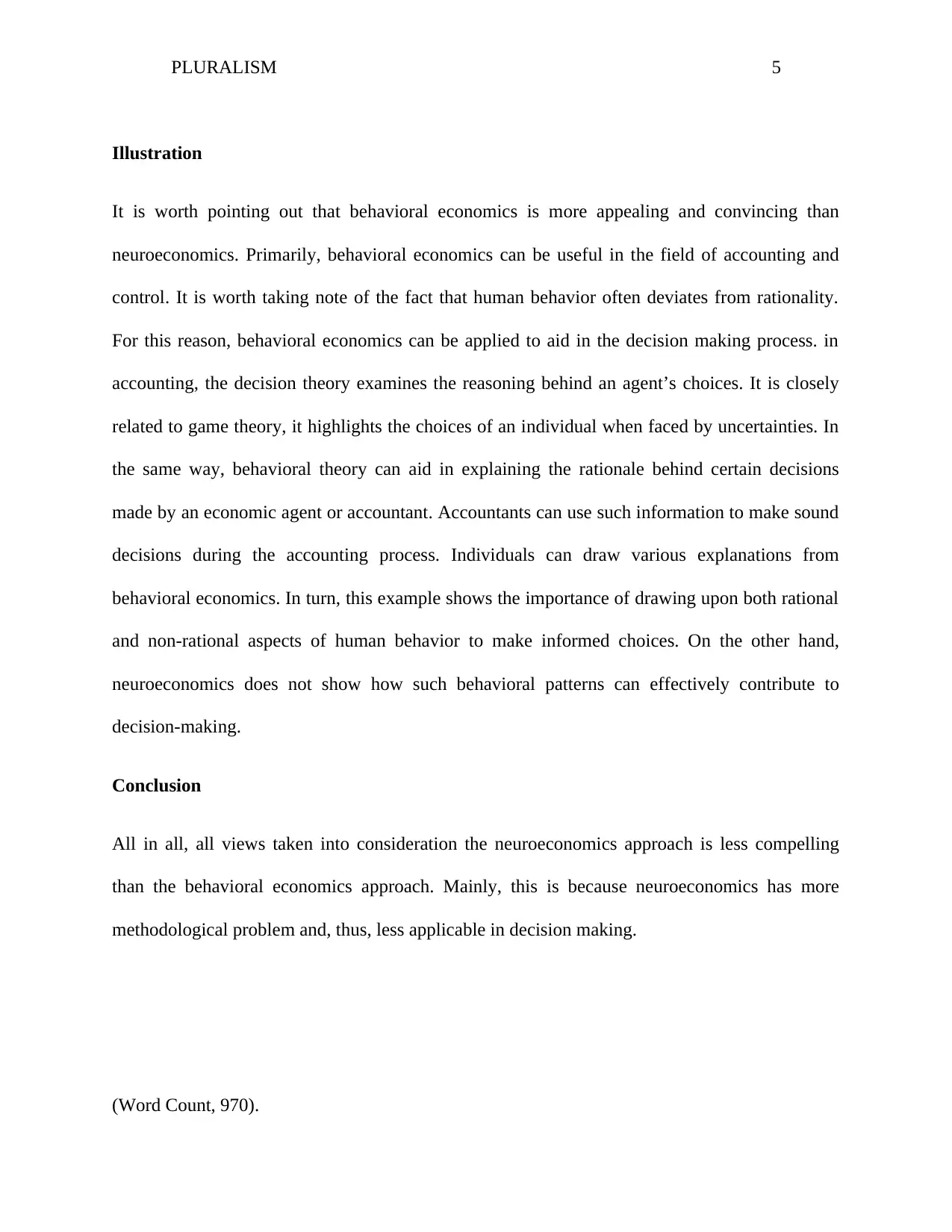
PLURALISM 5
Illustration
It is worth pointing out that behavioral economics is more appealing and convincing than
neuroeconomics. Primarily, behavioral economics can be useful in the field of accounting and
control. It is worth taking note of the fact that human behavior often deviates from rationality.
For this reason, behavioral economics can be applied to aid in the decision making process. in
accounting, the decision theory examines the reasoning behind an agent’s choices. It is closely
related to game theory, it highlights the choices of an individual when faced by uncertainties. In
the same way, behavioral theory can aid in explaining the rationale behind certain decisions
made by an economic agent or accountant. Accountants can use such information to make sound
decisions during the accounting process. Individuals can draw various explanations from
behavioral economics. In turn, this example shows the importance of drawing upon both rational
and non-rational aspects of human behavior to make informed choices. On the other hand,
neuroeconomics does not show how such behavioral patterns can effectively contribute to
decision-making.
Conclusion
All in all, all views taken into consideration the neuroeconomics approach is less compelling
than the behavioral economics approach. Mainly, this is because neuroeconomics has more
methodological problem and, thus, less applicable in decision making.
(Word Count, 970).
Illustration
It is worth pointing out that behavioral economics is more appealing and convincing than
neuroeconomics. Primarily, behavioral economics can be useful in the field of accounting and
control. It is worth taking note of the fact that human behavior often deviates from rationality.
For this reason, behavioral economics can be applied to aid in the decision making process. in
accounting, the decision theory examines the reasoning behind an agent’s choices. It is closely
related to game theory, it highlights the choices of an individual when faced by uncertainties. In
the same way, behavioral theory can aid in explaining the rationale behind certain decisions
made by an economic agent or accountant. Accountants can use such information to make sound
decisions during the accounting process. Individuals can draw various explanations from
behavioral economics. In turn, this example shows the importance of drawing upon both rational
and non-rational aspects of human behavior to make informed choices. On the other hand,
neuroeconomics does not show how such behavioral patterns can effectively contribute to
decision-making.
Conclusion
All in all, all views taken into consideration the neuroeconomics approach is less compelling
than the behavioral economics approach. Mainly, this is because neuroeconomics has more
methodological problem and, thus, less applicable in decision making.
(Word Count, 970).
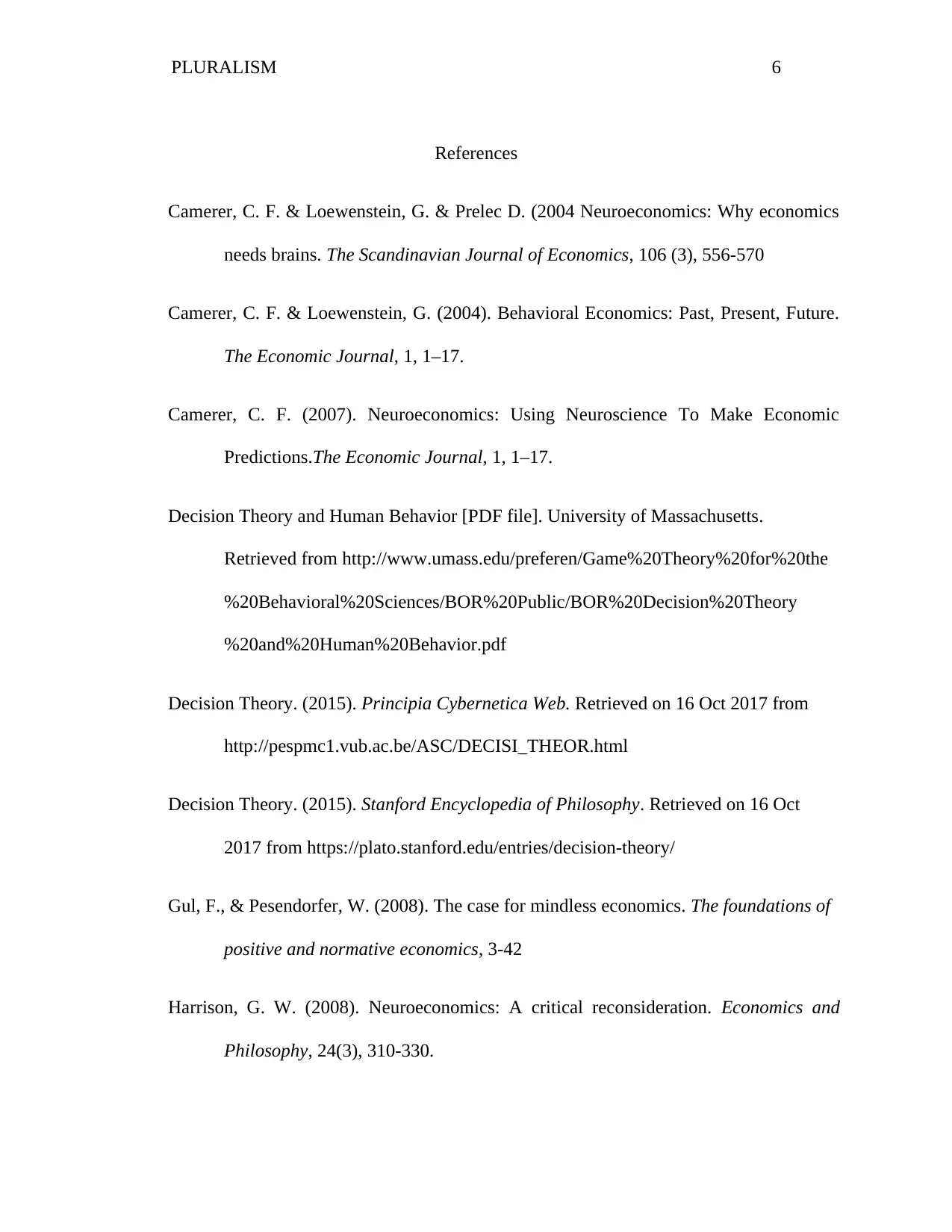
PLURALISM 6
References
Camerer, C. F. & Loewenstein, G. & Prelec D. (2004 Neuroeconomics: Why economics
needs brains. The Scandinavian Journal of Economics, 106 (3), 556-570
Camerer, C. F. & Loewenstein, G. (2004). Behavioral Economics: Past, Present, Future.
The Economic Journal, 1, 1–17.
Camerer, C. F. (2007). Neuroeconomics: Using Neuroscience To Make Economic
Predictions.The Economic Journal, 1, 1–17.
Decision Theory and Human Behavior [PDF file]. University of Massachusetts.
Retrieved from http://www.umass.edu/preferen/Game%20Theory%20for%20the
%20Behavioral%20Sciences/BOR%20Public/BOR%20Decision%20Theory
%20and%20Human%20Behavior.pdf
Decision Theory. (2015). Principia Cybernetica Web. Retrieved on 16 Oct 2017 from
http://pespmc1.vub.ac.be/ASC/DECISI_THEOR.html
Decision Theory. (2015). Stanford Encyclopedia of Philosophy. Retrieved on 16 Oct
2017 from https://plato.stanford.edu/entries/decision-theory/
Gul, F., & Pesendorfer, W. (2008). The case for mindless economics. The foundations of
positive and normative economics, 3-42
Harrison, G. W. (2008). Neuroeconomics: A critical reconsideration. Economics and
Philosophy, 24(3), 310-330.
References
Camerer, C. F. & Loewenstein, G. & Prelec D. (2004 Neuroeconomics: Why economics
needs brains. The Scandinavian Journal of Economics, 106 (3), 556-570
Camerer, C. F. & Loewenstein, G. (2004). Behavioral Economics: Past, Present, Future.
The Economic Journal, 1, 1–17.
Camerer, C. F. (2007). Neuroeconomics: Using Neuroscience To Make Economic
Predictions.The Economic Journal, 1, 1–17.
Decision Theory and Human Behavior [PDF file]. University of Massachusetts.
Retrieved from http://www.umass.edu/preferen/Game%20Theory%20for%20the
%20Behavioral%20Sciences/BOR%20Public/BOR%20Decision%20Theory
%20and%20Human%20Behavior.pdf
Decision Theory. (2015). Principia Cybernetica Web. Retrieved on 16 Oct 2017 from
http://pespmc1.vub.ac.be/ASC/DECISI_THEOR.html
Decision Theory. (2015). Stanford Encyclopedia of Philosophy. Retrieved on 16 Oct
2017 from https://plato.stanford.edu/entries/decision-theory/
Gul, F., & Pesendorfer, W. (2008). The case for mindless economics. The foundations of
positive and normative economics, 3-42
Harrison, G. W. (2008). Neuroeconomics: A critical reconsideration. Economics and
Philosophy, 24(3), 310-330.
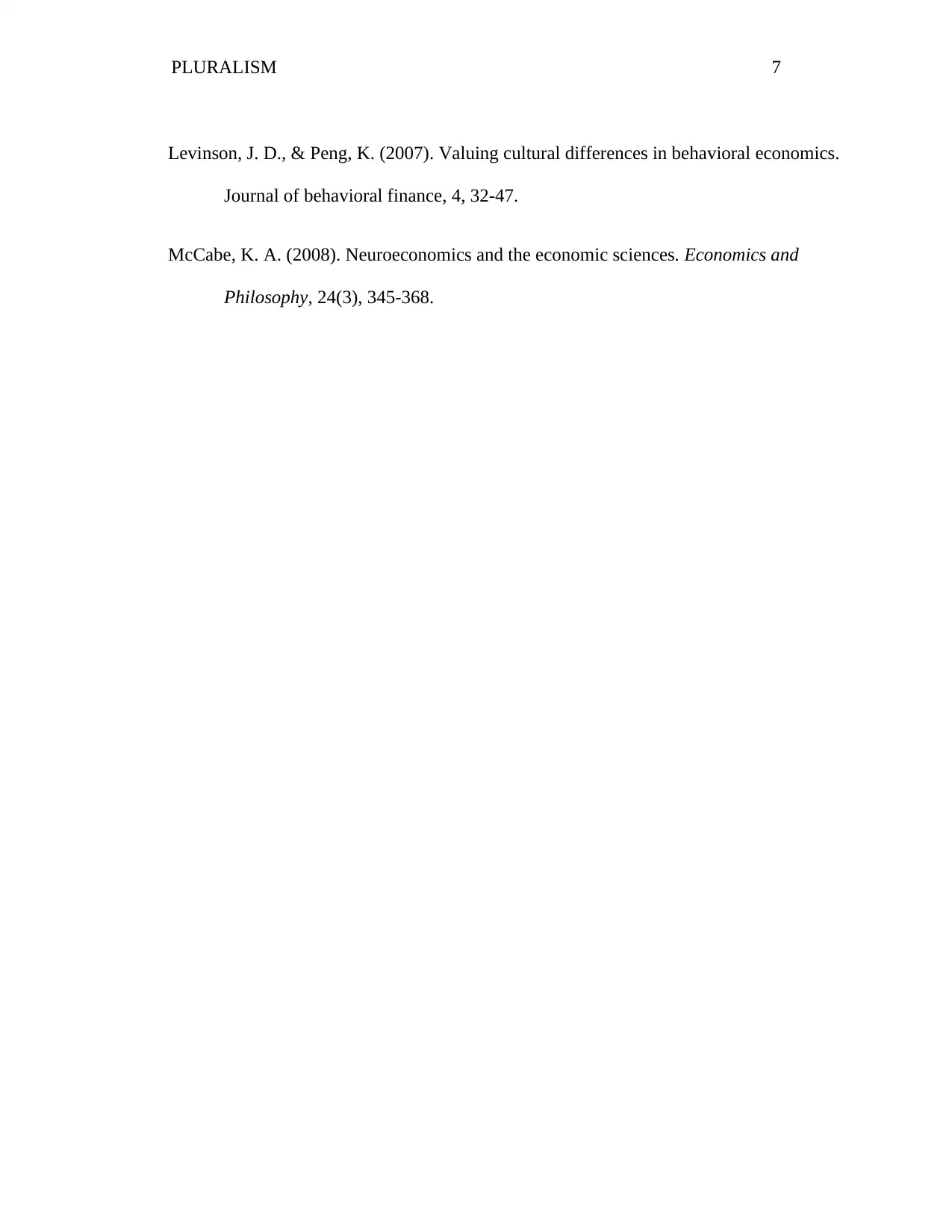
PLURALISM 7
Levinson, J. D., & Peng, K. (2007). Valuing cultural differences in behavioral economics.
Journal of behavioral finance, 4, 32-47.
McCabe, K. A. (2008). Neuroeconomics and the economic sciences. Economics and
Philosophy, 24(3), 345-368.
Levinson, J. D., & Peng, K. (2007). Valuing cultural differences in behavioral economics.
Journal of behavioral finance, 4, 32-47.
McCabe, K. A. (2008). Neuroeconomics and the economic sciences. Economics and
Philosophy, 24(3), 345-368.
1 out of 7
Your All-in-One AI-Powered Toolkit for Academic Success.
+13062052269
info@desklib.com
Available 24*7 on WhatsApp / Email
![[object Object]](/_next/static/media/star-bottom.7253800d.svg)
Unlock your academic potential
© 2024 | Zucol Services PVT LTD | All rights reserved.